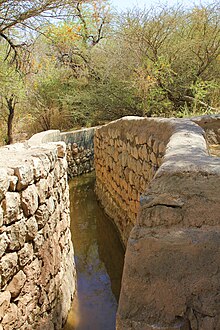

| UNESCO World Heritage Site | |
|---|---|

Falaj Daris
| |
| Location | Oman |
| Criteria | Cultural: (v) |
| Reference | 1207 |
| Inscription | 2006 (30th Session) |
The Aflaj Irrigation Systems of Oman are ancient water channels from 500 AD located in the regions of Dakhiliyah, Sharqiyah and Batinah. However, they represent a type of irrigation system as old as 5,000 years in the region named as qanat or kariz as originally named in Persia.[1]
"Aflaj" is the plural of "Falaj", which means "split into parts" in classical Arabic. This irrigation system effectively divided the water among all the inhabitants; it flowed by gravity from its original sources to homes and cropland. The complex included watchtowers to protect it, but also mosques and other buildings.[2]
In 2006, five Aflaj Irrigation Systems of Oman were added to the UNESCO list of World Heritage Sites: Falaj Al-Khatmeen, Falaj Al-Malki, Falaj Daris, Falaj Al-Mayassar and Falaj Al-Jeela.[3]
Declassified information by the British National Archives later revealed that the British government deliberately destroyed the Aflaj Irrigation systems and crops by air strikes during the Jebel Akhdar War in order to prevent locals in the interior of Oman from gathering crops and denying them access to water supplies. Wadi Beni Habib and the water channel at Semail were among the water supplies that were deliberately damaged. Air strikes on Saiq and Sharaijah rendered cultivation in the areas "hazardous". Furthermore, these documents reveal that the British Foreign Secretary gave the approval on 4 August 1957 to carry out air strikes without prior warning to the locals residing in the interior of Oman. The ban on visas for the press by the sultan and the ability of the British government to carry out air strikes discreetly using Masirah Airfield helped in sustaining the military operations under low profile.[4]
| Falaj | Coordinates | Area | Region[5] |
|---|---|---|---|
| Al-Katmeen | 22°56′0″N 57°40′0″E / 22.93333°N 57.66667°E / 22.93333; 57.66667 | 135.028 ha (0.52135 sq mi) | Dakhiliyah |
| Al-Malki | 22°44′0″N 57°46′0″E / 22.73333°N 57.76667°E / 22.73333; 57.76667 | 600 ha (2.3 sq mi) | Dakhiliyah |
| Daris | 22°59′0″N 57°32′0″E / 22.98333°N 57.53333°E / 22.98333; 57.53333 | 389.468 ha (1.50374 sq mi) | Dakhilyah |
| Al-Jeela | 22°47′0″N 59°10′0″E / 22.78333°N 59.16667°E / 22.78333; 59.16667 | 30.952 ha (0.11951 sq mi) | Sharqiyah |
| Al-Muyasser | 23°21′0″N 57°27′0″E / 23.35000°N 57.45000°E / 23.35000; 57.45000 | 300.501 ha (1.16024 sq mi) | Batinah |
There are three main types of aflaj in Oman: Dawoodi (long underground channels), Ghaili (shallow channels fed by ponds and running water), and Ainy (extracting water from springs). This diversity indicates the nuanced understanding and exploitation of local hydrogeological conditions to secure water throughout the year.[6] The aflaj systems feature access shafts built every 20 meters along the tunnel for ventilation and debris removal. A distinct feature is the ring of burnt clay at the shaft mouth, which prevents tunnel collapse and flooding, safeguards the water from pollution, and stops people and animals from falling in. This highlights the sophisticated engineering and preventive measures embedded in the design to ensure durability and cleanliness of the water supply.
Despite their ancient origins, about 3,000 aflaj systems remain functional, underlining their enduring value to Oman's agricultural and domestic water supply. The maintenance and care of these systems, as in the case of Birkat Al Mus, showcase the communal effort and the high regard for water monitors (Wakils), who play a crucial role in preserving the clarity and purity of the water, essential for the survival of these desert communities.[7]
{{cite web}}: Check |url= value (help)[permanent dead link]